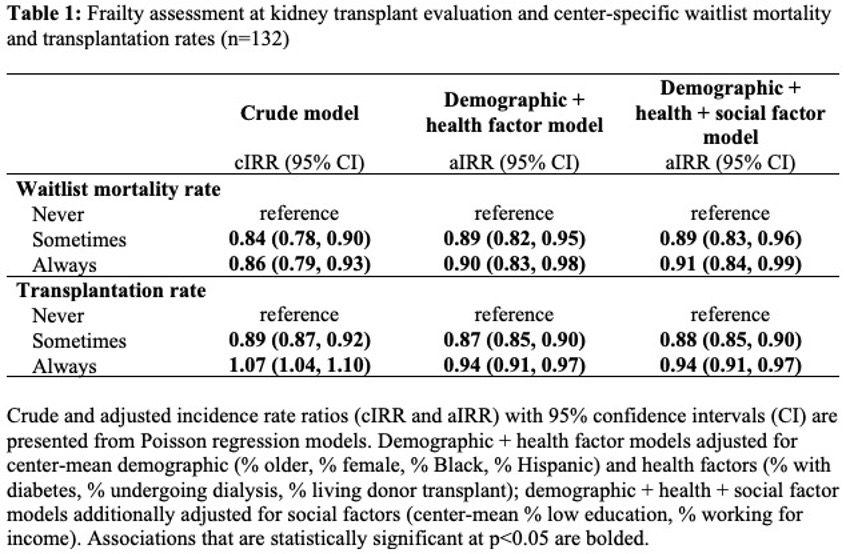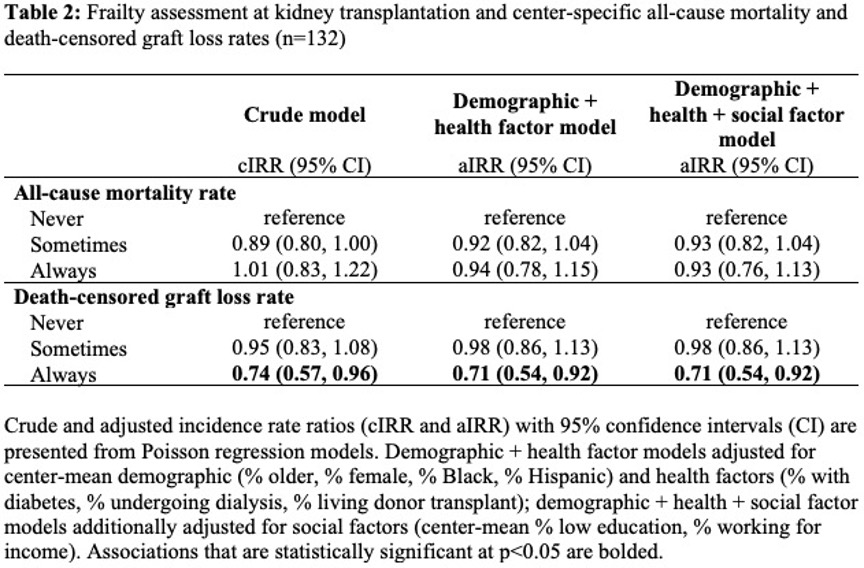Transplant Centers That Assess Frailty as Part of Clinical Practice Have Better Outcomes
1Department of Surgery, Johns Hopkins University School of Medicine, Baltimore, MD, 2Department of Medicine, Johns Hopkins University School of Medicine, Baltimore, MD, 3Comprehensive Transplant Center, Cedars-Sinai Medical Center, Los Angeles, CA, 4Division of Nephrology and Hypertension, Weill Cornell Medicine, New York, NY
Meeting: 2022 American Transplant Congress
Abstract number: 602
Keywords: Age factors, Kidney transplantation, Prognosis, Waiting lists
Topic: Administrative » Administrative » 01 - Quality Assurance Process Improvement & Regulatory Issues
Session Information
Session Name: Quality Assurance Process Improvement & Regulatory Issues
Session Type: Poster Abstract
Date: Saturday, June 4, 2022
Session Time: 5:30pm-7:00pm
 Presentation Time: 5:30pm-7:00pm
Presentation Time: 5:30pm-7:00pm
Location: Hynes Halls C & D
*Purpose: Frailty predicts adverse post-kidney transplant (KT) outcomes, yet impacts of frailty assessments on center-level outcomes remain unclear. We tested whether transplant centers assessing frailty as part of clinical practice have better pre- and post-KT outcomes in adult patients (18+) and older patients (65+).
*Methods: We conducted a survey of US transplant centers (11/2017-4/2018); 132 centers (response rate=65.3%) reported frequencies of frailty assessment at evaluation and KT. Center characteristics and clinical outcomes for patients during 2017-2019 were gleaned from the SRTR datasets. Poisson regression was used to estimate incidence rate ratios (IRRs) of waitlist mortality and transplantation in candidates and all-cause mortality and death-censored graft loss in recipients by frequency of frailty assessment.
*Results: Assessing frailty at evaluation was associated with lower waitlist mortality rate (always IRR=0.91,95%CI:0.84-0.99;sometimes=0.89,95%CI:0.83-0.96) and KT rate (always=0.94,95%CI:0.91-0.97;sometimes=0.88,95%CI:0.85-0.90); the associations with waitlist mortality rate (always=0.86,95%CI:0.74-0.99;sometimes=0.83,95%CI:0.73-0.94) and KT rate (always=0.82,95%CI:0.77-0.88;sometimes=0.92,95%CI:0.87-0.98) were stronger in older patients. Always assessing frailty at KT was associated with lower graft loss rate (IRR=0.71,95%CI:0.54-0.92) but not with mortality (IRR=0.93,95%CI:0.76-1.13).
*Conclusions: Assessing frailty at evaluation is associated with lower KT rate but better waitlist survival rate, particularly in older candidates; centers always assessing frailty at admission are likely to have better graft survival rate. Transplant centers may utilize frailty assessments as a tool to better allocate health care resources for patients identified as frail, particularly for older patients.
To cite this abstract in AMA style:
Chen X, Liu Y, Thompson V, Chu NM, King EA, Walston JD, Kobashigawa JA, Dadhania DM, Segev DL, McAdams-DeMarco MA. Transplant Centers That Assess Frailty as Part of Clinical Practice Have Better Outcomes [abstract]. Am J Transplant. 2022; 22 (suppl 3). https://atcmeetingabstracts.com/abstract/transplant-centers-that-assess-frailty-as-part-of-clinical-practice-have-better-outcomes/. Accessed December 12, 2025.« Back to 2022 American Transplant Congress


